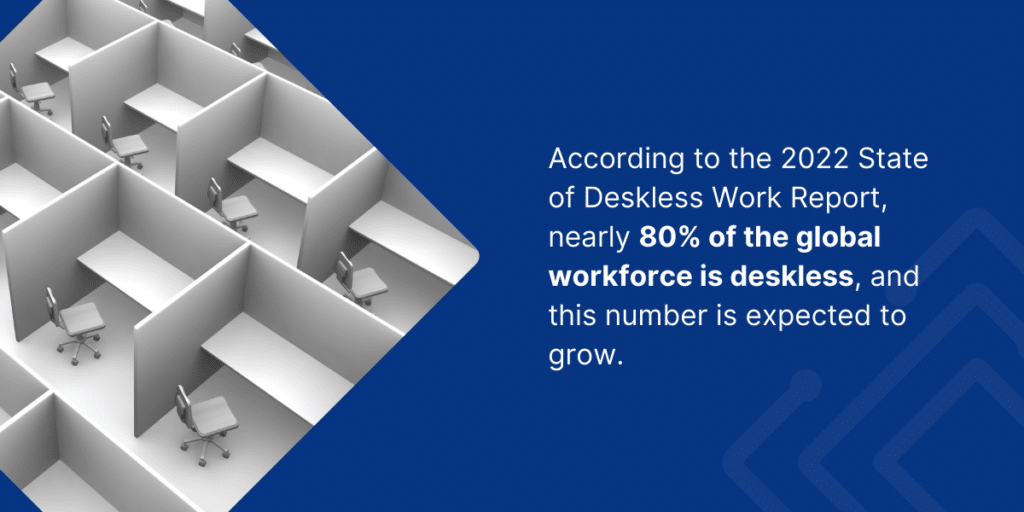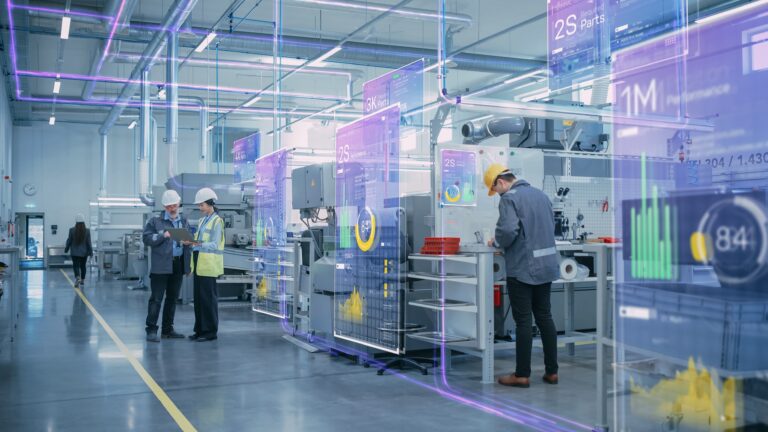In today’s technologically advanced world, deskless workers play a crucial role across various industries. These employees—often found in sectors such as manufacturing, healthcare, and energy—are the backbone of many operations, contributing significantly to productivity and service delivery. However, their unique working conditions also present distinct challenges that can affect both their efficiency and overall job satisfaction.
Addressing these challenges is not just a matter of improving workflows; it’s essential for boosting employee morale and ensuring organizational success. In this blog, we will explore the definition and scope of deskless workers, the common challenges they face, the impact of these challenges on productivity and business outcomes, effective solutions, and future trends in the deskless workforce.
Understanding Deskless Workers
Deskless workers are those who do not have a fixed office or desk but instead work in various environments, often on the move. This category includes field service technicians, healthcare providers, retail employees, and more. As industries evolve, the number of deskless workers continues to rise, reflecting a shift toward more flexible work arrangements.
Several key industries rely heavily on deskless workers:
- Manufacturing: Workers on the shop floor are integral to production processes.
- Food Processing: Employees work on production lines, ensuring the safe and efficient processing of food products, often in fast-paced environments.
- Transportation: Drivers and logistics personnel are essential for the movement of goods, requiring constant communication and coordination to ensure timely deliveries.
- Energy: Workers in this sector, including field technicians and operators, play crucial roles in maintaining and monitoring energy production and distribution systems, often in remote locations.
- Construction: Skilled laborers and site managers constantly navigate changing environments.
- Healthcare: Nurses and caregivers provide essential services outside the traditional office setting.
- Hospitality: Workers in hotels, restaurants, and event venues provide services such as food preparation, housekeeping, and customer service.
According to the 2022 State of Deskless Work Report, nearly 80% of the global workforce is deskless, and this number is expected to grow as businesses adapt to the needs of a mobile workforce.

Common Challenges Faced by Deskless Workers
1. Communication Barriers
Deskless workers often struggle with communication, making it difficult to access critical information and stay connected with their teams. Without real-time communication tools, important updates can be missed, leading to misunderstandings and inefficiencies.
Communication barriers significantly impact deskless workers by hindering their ability to access critical information and maintain connections with their teams. This often results in decreased productivity, as employees may face delays in task completion due to misunderstandings or unclear instructions.
2. Technology Gaps
Many deskless workers face challenges due to limited access to necessary tools and software. Outdated technology can hinder productivity and make it difficult for employees to perform their tasks effectively. Furthermore, inadequate training on available tools can exacerbate these issues.
Technology gaps create significant challenges for deskless workers, as many face limited access to the necessary tools and software required for their roles. This often leads to decreased productivity, as outdated or inadequate technology can slow down processes and hinder employees’ ability to perform tasks efficiently.
3. Workforce Management Issues
Scheduling conflicts and shift changes are common issues that deskless workers encounter. Managing attendance and performance can be inefficient, leading to confusion and dissatisfaction among employees.
Scheduling challenges can lead to high turnover rates among deskless workers. Employees who feel unsupported or disconnected from their teams are less likely to stay, resulting in increased recruitment and training costs for organizations.
4. Health and Safety Concerns
Deskless workers often face risks associated with physical labor and remote work environments. Without immediate access to safety resources and protocols, employees may feel vulnerable, which can impact their morale and productivity.
The absence of immediate access to safety resources and protocols can leave employees feeling vulnerable and unprotected, which not only heightens anxiety but can also diminish their overall morale. This sense of insecurity can lead to decreased productivity, as workers may be preoccupied with potential hazards rather than focusing on their tasks.
Solutions for Deskless Worker Challenges
1. Enhancing Communication
Investing in mobile apps and tools designed for real-time updates can dramatically improve communication among deskless workers. These platforms facilitate instant messaging, file sharing, and access to essential information, helping teams stay connected. Enhancing communication not only reduces misunderstandings and increases efficiency but also fosters a collaborative culture, where employees feel valued and supported in their roles.
2. Investing in Technology
Organizations should prioritize the introduction of user-friendly software for scheduling and task management. Providing deskless workers with the right tools can empower them to perform their jobs more effectively and efficiently. Bridging the technology gap not only enhances productivity but also fosters a sense of confidence and engagement among employees, leading to improved job satisfaction and lower turnover rates.
3. Implementing Flexible Workforce Management Solutions
Automated scheduling and attendance tracking can alleviate many workforce management issues. These solutions can streamline processes, reduce conflicts, and help organizations maintain a better overview of their workforce. Additionally, implementing flex scheduling allows for more adaptive work arrangements, accommodating the diverse needs of deskless workers while improving overall job satisfaction and retention.
4. Promoting Health and Safety
Providing training programs and resources to support deskless workers is essential. Organizations must also ensure that safety equipment and protocols are readily available, fostering a culture of safety that prioritizes employee well-being.

Future of Deskless Work
With the rapid speed of technological and AI advancements, predictions suggest that tools and resources for deskless workers will become more sophisticated. Innovations in mobile applications and wearable technology may enhance communication and productivity, enabling real-time data access and facilitating smoother workflows. For instance, IoT devices might offer insights into equipment performance and maintenance needs, leading to more proactive management of resources.
Moreover, the rise of artificial intelligence (AI) will likely play a significant role in automating routine tasks, allowing deskless workers to focus on higher-value activities. AI-driven analytics can help organizations forecast demand, optimize schedules, and improve safety measures, leading to more informed decision-making.
At Indeavor, we are committed to supporting the future of deskless work by providing innovative solutions that address the unique challenges faced by these workers. Our platform leverages cutting-edge technology to enhance communication, streamline scheduling, and ensure compliance with safety protocols. By equipping organizations with the tools they need to manage their deskless workforce effectively, we enable businesses to optimize productivity and improve employee satisfaction.
To thrive in a competitive landscape, organizations must prioritize continuous improvement. This means regularly assessing the needs of deskless workers and adapting solutions to enhance their work experience and overall productivity. Implementing feedback loops, where employees can voice their challenges and suggest improvements, will be essential. By fostering a culture of open communication and innovation, companies can not only improve employee satisfaction but also drive operational efficiency.
As we look to the future, the deskless workforce will continue to grow and evolve, requiring organizations to be agile and responsive. With Indeavor’s innovative solutions, businesses can embrace technological advancements and focus on the unique needs of their deskless workers, creating an empowered workforce that significantly contributes to their success.
Conclusion
In navigating the challenges faced by deskless workers, organizations can unlock significant improvements in both productivity and employee satisfaction. By addressing communication barriers, bridging technology gaps, streamlining workforce management, and prioritizing health and safety, businesses can create a supportive environment that empowers their mobile workforce. As industries continue to evolve and the number of deskless workers rises, it is crucial for organizations to adopt innovative solutions that cater to their unique needs.
At Indeavor, we are dedicated to providing the tools necessary for organizations to manage their deskless workforce effectively, enhancing operational efficiency while fostering a culture of safety and engagement. We encourage you to take a moment to assess your own deskless workforce and identify any challenges that may need addressing. Consider implementing solutions that can make a difference for these vital employees.
About the Author
Claire Pieper is the Digital Marketing Specialist for Indeavor. In her role, she specializes in crafting strategic and engaging content, ensuring that customers are well-informed. Claire is dedicated to enhancing the customer experience and optimizing the user journey through Indeavor’s solutions. To learn more or get in touch, connect with Claire on LinkedIn.







